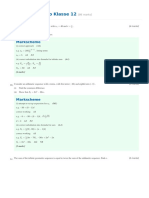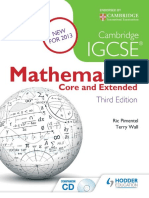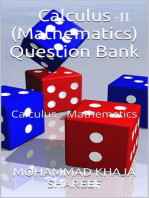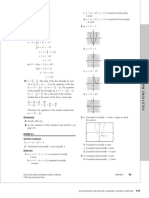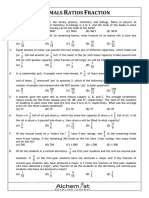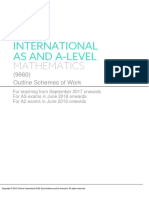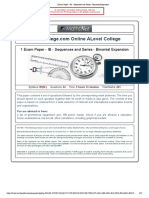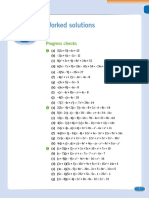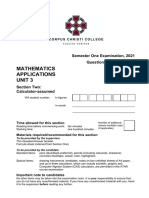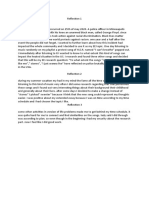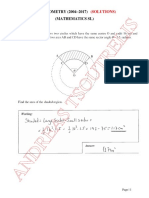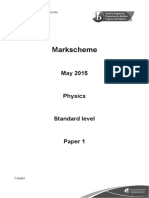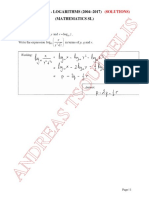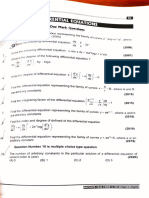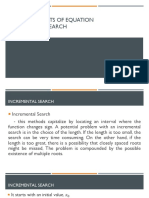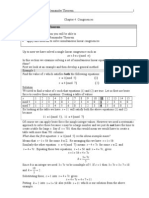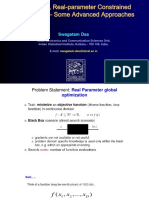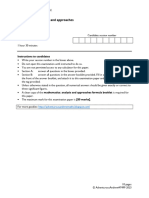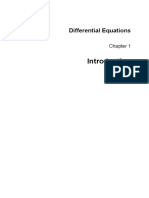Mathematics Course Companion SL
Uploaded by
Aziz KarimMathematics Course Companion SL
Uploaded by
Aziz KarimIB Mathematics
“Analysis and approaches” SL and HL
Course companion
Ioannis. E. Asimakis
2
3
Contents
Section I (Common SL and HL)………………….4
Topic 1-Numbers and algebra……………………5
Topic 2-Functions…………………………………..26
Topic 3-Trigonometry and geometry…………...54
Topic 4-Statistics and probabilities…………….83
Topic 5-Calculus……………………………………107
Bibiliography………………………………………..142
4
Section I
Common SL and HL
Topics
5
Topic 1
Numbers and algebra
6
Numbers
Rounding numbers
Basic Rules of Rouning
When you "round to the nearest _____" regardless of what goes in
the blank the steps are nearly always the same:
Identify which place value you are rounding to. The smaller
the place value, the more accurate the final result will be.
Look to the next smallest place value, the digit to the right of
the place value you're rounding to. For example, if you want to
round to the nearest ten you'd look at the ones place.
If the digit in the next smallest place value is less than five
(0, 1, 2, 3, or 4), you leave the digit you want to round to as-is.
Any digits after that number (including the next smallest place
value you just looked at) become zeros, or drop-off if they're
located after the decimal point. This is called rounding down.
If the next smallest place value is greater than or equal to
five (5, 6, 7, 8, or 9), you increase the value of the digit you're
rounding to by one (+1). Just like before, any remaining digits
before the decimal point become zeros, and any that are after the
decimal point are dropped. This is called rounding up.
Scientific notation
Scientific notation (also referred to as scientific form or standard
index form, or standard form in the UK) is a way of expressing
numbers that are too big or too small to be conveniently written
in decimal form.
In scientific notation all numbers are written in the form
For example and can be written using scientific
notation in the form:
7
Significant figures
The significant figures (also known as the significant digits) of a
number are digits that carry meaning contributing to its
measurement resolution.
All non-zero digits are significant: 1, 2, 3, 4, 5, 6, 7, 8, 9.
Zeros between non-zero digits are significant.
Leading zeros are never significant.
In a number with or without a decimal point, trailing zeros
(those to the right of the last non-zero digit) are significant
provided they are justified by the precision of their derivation.
When multiplying or dividing, the answer must have the
same number of significant figures as the least significant figure
in the problem. Your answer can not be more accurate than any
measurement in the problem
8
Examples
The number 12.345
Rounded to Rounded to
Precision significant figures decimal places
6 12.3450 12.345000
5 12.345 12.34500
4 12.34 or 12.35 12.3450
3 12.3 12.345
2 12 12.34 or 12.35
1 10 12.3
0 N/A 12
The number
Rounded to Rounded to
Precision significant figures decimal places
7 0.01234500 0.0123450
6 0.0123450 0.012345
5 0.012345 0.01234 or 0.01235
4 0.01234 or 0.01235 0.0123
3 0.0123 0.012
2 0.012 0.01
1 0.01 0.0
0 N/A 0
9
Exercises
1. Round the following numbers to 4 decimal places:
a. 23.56738
b. 345.57893
c. 236.43899
d. 3478.23456
2. Write the following numbers in scientific notation:
a. 23.3
b. 0.0453
c. 0.000451
d. 2,340,000
e. 210,000,000,000
3. Find the number of siginifcant figures of the following
numbers:
a. 2,040
b. 2,040.0
c. 0205.0
d. 0.002007
e. 0.0020070
f. 200,000
g. 0.0003
h. 0.000300
4. Round the following numbers to 3 significant figures:
a. 234,555,359
b. 0.090035
c. 939.25
d. 14,090
e. 0.008499
f. 11.1111
10
Exponents
Exponentiation rules
o ( )
o ( ) ( )
o ( )
o . /
o √
If then
If then
If then .
If then .
11
Exercises
1. A square-ended cuboid has volume , where and are
lengths. A cuboid for which has volume 128 cm3.
Find .
2. Solve the following equations
a.
b.
c.
d.
3. Write the following expression as a power of 2:
4. If calculate the value of
5. Write ( √(√ )) as a single power of .
6. Solve the following equation
7. If show that :
a. is a multiple of 7.
b. is a multiple of 5.
8. Prove that .
12
Logarithms
If and then:
Logarithm properties:
o ( )
o . /
o for every appropriate
If then
If then
where . /
13
Exercises
1. Write the exact value of the following expressions:
a. √
√
b. √
c.
2. If write the following expressions as
functions of :
√
a.
√
b.
3. Find the values of for which:
a.
b.
c.
4. Show that:
a.
b.
14
5. Solve the following equation:
( )
6. Solve the following equation:
( ) ( )
7. Find the values of if they satisfy the equations below:
a. {
b. {
8. Solve the following inequalities:
a.
b.
c. . / ( )
9. Find the values of for which:
15
Sigma notation
By sigma notation we mean the symbol, Σ, which is the Greek upper case
letter, S. The summation sign, Σ, instructs us to sum the elements of a
sequence. A typical element of the sequence which is being summed
appears to the right of the summation sign.
The elements that appear in the sigma notation are:
The variable of summation, i.e. the variable which is being summed.
The variable of summation is represented by an index which is placed
beneath the summation sign. The index is often represented by i. (Other
common possibilities for representation of the index are j and t.) The index
assumes values starting with the value on the right hand side of the
equation and ending with the value above the summation sign.
The starting point for the summation or the lower limit of the
summation
The stopping point for the summation or the upper limit of
summation
For example :
where are elements of a sequence.
Using this notation we can write large sums, for example the sum of the first
50 positive even numbers:
∑( )
16
Examples of sigma notation expression for sums:
Some properties of the sigma notation
∑ ∑ where c is any constant number not depending
on the summation index
∑ ∑ ∑
∑ ∑ ∑
∑
17
Exercises
1. Expand the following sums:
a. ∑
b. ∑
c. ∑
2. Use sigma notation to express the following sums:
a.
b. 4+0.4+0.004+…+0.00000000004
c.
d.
e.
3. Find the coefficient of in the expansion of:
∑( )
4. Find the coefficient of in the expansion of:
( ) ∑( )
18
Sequences and series
A sequence is a relation (function) between the set of natural
numbers (except from 0) and the set of real numbers. The usual
notation for symbolizing the term of a sequence is .
A series is a sequence of the sum of the terms of another
sequence and is usually written in the form of sigma notation:
An arithmetic sequence is a sequence of numbers such that
the difference between the consecutive terms is constant.The
term is :
( )
while the sum of the first terms is:
∑ ( ) , ( ) -
A geometric sequence is a sequence of numbers where each
term after the first is found by multiplying the previous one by a
fixed, non-zero number called the common ratio. The term is
:
while the sum of the first terms is:
∑
19
If then the infinite sum of the sequence converges (it is
a real number not infinity) and is given by:
Tip:
20
Exercises
1. The first term of a geometric sequence is 2 while the second term
is 1. Find the tenth term.
2. In an arithmetic sequence, the third term is 10 and the fifth term
is 16.
a. Find the common difference.
b. Find the first term.
c. Find the sum of the first 20 terms of the sequence
3. In a geometric series, and .
a. Find the value of r.
b. Find the value of such that
4. In a geometric sequence, the fourth term is 8 times the first term.
The sum of the first 10 terms is 2557.5. Find the 10th term of this
sequence.
5. Calculate the following sums:
a. ∑ ( )
b. ∑ ( )
c. ∑ . /
6. A metal rod 1 metre long is cut into 10 pieces, the lengths of
which form a geometric sequence. The length of the longest piece
is 8 times the length of the shortest piece. Find, to the nearest
millimetre, the length of the shortest piece.
21
7. Find the sum of all integers, between 10 and 200, which are
divisible by 7.
8. Find the sum of the first one hundred positive multiples of 3.
9. The sum of the second and third terms of a geometric sequence is
96. The sum to infinity of this sequence is 500. Find the possible
values for the common ratio.
10. In an arithmetic sequence the sum of the first twenty terms is
while the sum of the first 12 terms is
Find the first term and the common difference.
11. The sum of the first n terms of a sequence is given by:
. Prove that it is an arithmetic sequence and find the
first term and common difference.
12. The yearly income of a family is shown below for four consecutive
years:
Year 2015 2016 2017 2018
Income 32,000 33,450 35,000 36,490
By approximating the family income with an appropriate
arithmetic sequence:
a. Find the predicted family income at 2022.
b. Find the total income of the family through the years
2015 - 2022.
22
Financial applications
of geometric series
If a principal of is invested in an account that yields an
interest of annually, then the future value after years is
given by:
. /
If a principal of is invested with an interest which is
paid times per year then the future value after years is given
by:
. /
If the present value is decreased with (deprecation)
then the above formulas for each case become:
. /
. /
23
Exercises
1. How much should be invested now to yield 25,000$ in 3
years time , if the money can be invested ar a fixed rate of
4.2% compounded quarterly?
2. A sum of 5000$ is invested with a compound interest rate of
2% per annum.
a. Find the future value after 10 years if the interest is
compounded annually.
b. Find the future value after 10 years if the interest is
compounded quarterly (every three months)
c. Find the number of full years needed for the
investment to exceed 10000$.
3. A customer want to invest 1000$ in a bank. If the interested
is compounded quarterly how much interest must be offered
to him in order his investment to be 2000$ dollars after 10
years?
4. The population of a city increases with a rate of 5.2% every
year and its current population today is 800,000.
a. Find the population of the city in 7 years from now.
b. Find the population of the city 7 years ago.
c. Find the numbers of full years needed for the city
population to double.
24
Binomial Theorem
The number of ways of choosing objects out of is:
. /
( )
For every and
. / . /
The binomial theorem states that
( ) ∑. / ∑. /
Another way of defining the coefficients of the expansion of
( )
is Pascals’ triangle. To build the triangle, start with "1" at the
top, then continue placing numbers below it in a triangular
pattern. Each number is the numbers directly above it added
together.
25
Exercises
1.Expand in ascending powers of the following expressions
a.( )
b.( )
c. ( )
2. Find the coefficient of in the expansion of ( ) .
3. Find the constant term in the expansion of . / .
4. Consider the expansion of . / The constant term is
28672, find all the possible value(s) of
5. Consider the expansion of . / where The coefficient
of the term containing is equal to the term containing
Find
6. Given that
( ) ( )
find the values of and .
7. Find the coefficient of in the expansion of ( ) .
26
Topic 2
Functions
27
Functions - basics
A function is a relation between two sets , the domain (the
inputs of the function) and the range (the output of the
function) such that for every there exist exactly
one
Let be a real function. If for every there exists only
one such that ( ) then is an one on one function,
otherwise it is a many to one function.
The set of points ( ( )) on a coordinate plane is the graph
of
Vertical line test: If is a function then every vertical line
on the plane meets the graph of at one point at most.
Horizontal line test: If is an one to one function then
every horizontal line meets the graph of at one point at
most.
The of a function is the point where it meets the
axis (It can be found by solving the equation ( ) ). The
is the point where the graph of the function meets
the axis.
Let and be real functions, then the composition is a
new function such that ( )( ) ( ( )).
The points of intersection between two functions and ,
can be found by solving the equation ( ) ( ).
28
Exercises
1. By sketching the graphs of the following functions using
technology determine which are “1-1” functions and which
are not:
a. ( )
b. ( )
c. ( )
d. ( )
2. Find the domain of the following functions:
a. ( ) √
b. ( ) √
c. ( ) √
d. ( ) ( )
e. ( ) (√ )
f. ( ) √ ( )
g. ( ) √
29
3. Find the range of the following functions:
a. ( ) √
b. ( )
4. Find all the intercepts of the following functions:
a. ( ) ( )
b. ( )
c. ( )
d. ( )
5. Write the following functions as the composition of two or
more functions.
a. ( ) √
c. ( )
c. ( ) (√ )
6. Let ( ) and ( ) . Find the values of ( ( ))
and ( ( )).
30
7. Let ( ) √ and ( ) . Find and and
state their domain and range
8. Let and be two functions such that ( ) .
If ( ) find the equation of ( )
9. Find the point(s) of intersection between the following
functions:
a. ( ) and ( )
b. ( ) and ( )
31
Lines
A linear function is a function of the form ( )
General form of the equation of a line:
Where cannot be simultaneously zero.
Given two points ( )( ) that are contained on the
line, then its gradient (slope) is:
If the line is parallel to the x axis then and it has the
form
If the line is perpendicular to the x axis then the gradient is
undefined and the line has the form
The gradient of the line is the tangent of the angle which has
initial side the x axis and terminal side the line, counting
counterclockwise that is
32
If two lines
o are parallel then
o are perpendicular then
If one point ( ) contained on the line is known and the
gradient is known then the equation of the line is given
by:
( )
The point of intersection of two lines is the solution to the
corresponding simultaneous system.
33
Exercises
1. A linear function contains the points ( ) and ( ).
Find its equation.
2. Find the equation of the line which contains the points (1,1),
(12,8)
3. The price of a cellphone decreases linearly with time. When
it came out its value was ,while after 4 months it had
dropped to .
Find the formula for its value months after its introduction
to the market.
4. Find the point of intersection of the lines :
5. Find the equation of the line which parallel to the line with
equation:
and contains the point (6,9).
6. Find the equation of the line which is perpendicular to the
line with equation:
and contains the point (5,4).
34
7. Find the equation of the line which contains the point M(2,1)
and intersects the lines:
at the points A,B such that M is the midpoint of A and B.
8. Show that the lines :
contain the same point.
9. Show that the points A(1,-1),B(2,0),C(-1,-3) are colinear.
35
Quadratic equations and functions
The quadratic equation is an equation of the form:
The discriminant is
.
o If then there are two real unequal roots
√
.
o If then there is one double root .
o If then there are no real roots.
The quadratic function is a function of the form
( ) .
o If the parabola is open upwards.
o If the parabola is open downwards.
o The intercepts are the solution of the corresponding
equations.
o The line is the axis of symmetry, so .
o Vertex form of the parabola: ( )
o Factorized form of the parabola: ( )( )
Vietta’ s formulas:
o
o
36
Exercises
1. Write the following quadratic functions in vertex form:
a. ( )
b. ( )
c. ( )
2. Write the following quadratics in factorized form:
a. ( )
b. ( )
c. ( )
3. Let ( ) ( ) . The vertex of the parabola is at (2,3)
and the graph passes through the point (1,7). Find the
values of
4. Show that the equation ( ) ( ) has two
real distinct solutions for every real value of .
5. Find the range of values of the parameter such that
for every .
6. Solve the following inequalities:
a.
b.
c.
d.
37
7. Solve the following equation:
8. Show that for every value of the equation:
has no real roots.
9. The following graph is the graph of function .
Show that the function can be written in the form
( )
10. Let f be a quadratic function. Part of is shown below
Write in the form ( ) ( )
38
11. Let be a quadratic function. Part of is shown below.
Write in the form ( ) ( )( )
12. Find the values of for which the roots of the equation
are closest together.
39
Rational functions
( )
A rational function is a function of the form ( ) ( )
where ( ) ( ) are polynomials.
If the numerator and the denominator are of the same
degree then the horizontal asymptote of is the line
where and are the coefficients of the leading terms of the
numerator and denominator respectively.
If the numerator is of higher degree than the denominator
then there are no horizontal asymptotes (although there may
be slant asymptotes).
If the denominator is of higher degree than the numerator
then the horizontal asymptote is
The roots of the denominator which are not roots of
the numerator form the vertical asymptotes .
If a number is a root of both numerator and denominator
calculations for canceling out terms must be performed in
order to check if it is a vertical asymptotes.
40
The simplest case of rational function is
( )
which has as a horizontal asymptote and as
vertical asymptote.
41
Exercises
1. Find the equations of all asymptotes of the following
functions and sketch their graphs indicating all asymptotes
and intercepts:
a. ( )
b. ( )
c. ( )
d. ( )
e. ( )
f. ( )
2. Let ( ) . If has as a horizontal asymptote,
as a vertical asymptote and passes through ( ), find
the values of and , as well as the y intercept.
3. For the following functions find all asymptotes and
intercepts and state the domain an range:
a. ( )
b. ( )
42
4. The graph of the function ( ) is shown below.
a. Find the values of and
b. Find the intercept.
43
Inverse functions
If a function is an 1-1 function then another function
can be defined such that if ( ) ( ) .
The domain of is the range of and the range of is the
domain of
The intercept of is the y intercept of and the y intercept
of is the intercept of .
The graphs of and are symmetric with respect to the line
The point of intersection of and is on the line if
they are increasing functions.
( )( ) ( )( ) .
To find the inverse function solve the equation ( ) with
respect to and then switch variables.
44
Exercises
1. Find the inverse function of the following functions and find
their range:
b. ( )
c. ( )
d. ( )
e. ( ) ( )
2. Let ( ) ( ) .
a. Find the domain of .
b. Find the range of by finding its inverse.
c. Verify that ( )( ) .
3. Let ( ) and ( ) .
a. Find ( ) ( )
b. Find ( ) ( )
c.
4. Let ( ) for .
a. Find the smallest value of such that has an inverse.
b. Find the inverse function and its domain and range.
5. A function for which ( ) ( ) is true for all is called a
self inverse. Find the value of , such that:
( )
is an inverse function.
45
Exponential and logarithmic functions
Exponential function: ( ) ( )
o If then is an increasing function:
o If then is a decreasing function:
46
Logarithmic function: ( ) ( )
o If then is an increasing function:
o If then is a decreasing function:
The exponential function has always as a horizontal
asymptote. The logarithmic functions has always as a
vertical asymptote.
The exponential function is the inverse of the logarithmic
function and visa versa.
47
Exercises
1. Let ( ) .
a. Find the domain and range of , and the equations of
its asymptote(s).
b. Find the inverse of and state its domain and range
and its asymptote(s).
2. Let ( ) ( )
a. Find the domain and range of , and the equations of
its asymptote(s).
b. Find the inverse of and state its domain and range
and its asymptote(s).
3. The quantity in grams of a radioactive substance after
years is given by the formula:
( )
a. If initially there are 5 grams of the substance write
down the value of .
b. If the half life time is 1600 years write the exact value
of .
c. Find the number of full years needed so only 0.001
grams of the substance remain.
4. A population of rare birds can be modeled by the equation
, where is the initial population and it is
estimated that .
a. Find the value of .
b. Find the least number of full years such that
48
5. Let ( ) ( ) ( ).
a. Find the domain of .
b. Write down as a single logarithm.
c. Find and state its range.
6. Find the values of such that the function
( ) ( )
is an increasing function.
7. Let ( ) .
a. Find the domain of .
b. Find all the intercepts of the graph of .
c. Solve the inequality ( ) ( )
49
Transformations of graphs
Let
Vertical shifts:
( ) ( ) ( ) is a shift units up.
( ) ( ) ( ) is a shift units down.
Horizontal shifts:
( ) ( ) ( ) is a shift units to the right.
( ) ( ) ( ) is a shift units to the left.
Translation by the vector . /
( ) ( ) ( ) is a shift units horizontally
and vertically.
50
Vertical dilation:
( ) ( ) ( ) is a vertical stretch by a factor .
o The points move further from the axis
if (stretch).
o The points move closer to the axis
if (shrink).
Horizontal dilation:
( ) ( ) ( ) is a horizontal stretch by a factor .
o The points move further from the axis
if (stretch).
o The points move closer to the the axis if (shrink).
Reflections:
( ) ( ) ( ) is a reflection with respect to the axis.
( ) ( ) ( ) is a reflection with respect to the axis.
Important Tip!: Have in mind that the sequence of
transfromations is important. While you can perform vertical
and horizontal shifts at any order, this is not valid when
shift are followed by dillations and vica verca.
51
Exercises
1. Describe the transformations that must be applied in order
( ) to be transformed to:
a. ( ) ( )
b. ( ) ( )
c. ( ) ( )
d. ( )
e. ( )
2. Write ( ) in terms of ( )
3. The graph of ( ) is transformed to the graph of
( ) by a translation units vertically followed by
a horizontal stretch with scale factor . Find the values
of and .
4. Describe the sequences of transformations in order to
transform
( ) ( ) to ( ) .
52
5. Write in the form ( ) the function that is defined
from ( ) after the following transformations:
a. Shift to the right 3 units.
b. Shift down 1 unit.
c. Vertical stretch by a factor of
d. Horizontal stretch by a factor of 4.
6. Sketch the graph of ( ) and ( ) if the graph of
( ) is
graphed below for the following cases.
53
7. The graph of ( ) is shown below.
Sketch the graphs of:
a. ( ) ( )
b. ( ) ( )
8. The graph of ( ) has a maximum point with coordinates
( ).
Find the coordinates of the maximum point of:
a. ( ) ( ( )) .
b. ( ) ( ) .
9. The function has one local minimum with coordinates
( ) and one local maximum with coordinates ( ).
Find the local maximum and local minimum of the function
( ) ( ) .
54
Topic 3
Τrigonometry and Geometry
55
Cartesian geometry in 2 and 3 dimensions
Every point on a plane can be represented by two numbers
( ) where is the distance of the point from the axis and
is the distance of the point from the axis.
Distance between two points ( ) and ( ) on a
plane:
√( ) ( )
Midpoint between two points ( ) and ( ) on a
plane:
( )
On a three dimensional space every point can be represented by
an ordered triplet ( ) such that is the distance from the
plane is the distance from the plane and is the distance
from the plane.
Given two points ( ),( ):
Distance between two points ( ) and ( ):
√( ) ( ) ( )
Midpoint between two points ( ) and ( ):
( )
56
Exercises
1. Suppose ( ) ( ) and ( ). Check if
the triangle is a right triangle.
2. Let A(-1,6) and B(-9,-2). Find:
a. The point on the axis that is equidistant from A and
B.
b. The point on the axis that is equidistant from A and
B.
3. Show that if ( ) is a point on the surface of a
sphere with radius and center at ( ) then:
( ) ( ) ( )
4. Let ( ), ( ) and ( ). Find the distance
between the midpoints of the line segments and .
5. The distance from ( ) to ( ) is 7 units.
Find the value(s) of .
57
Solids
Prisms
A prism is a three dimensional solid which has two bases that are
congruent shapes lying on parallel planes.
A very important feature of solids is their volume which can be
found by the following formula:
Rectangular solid
√
Cube
√
58
Cylinder
Other important solids
Pyramid
Cone
59
Sphere
60
Exercises
1. A cone has volume . If its radius is doubled and its
height is tripled find the new volume of the resulting cone.
2. The ratio of the lateral surface area of cylinder A to the
lateral surface area of cylinder B is . If the cylinders have
the height find the ratio of their volumes.
3. The ratio of the surface are of sphere A to the surface area
of sphere B is . Find the ratio of their volumes.
4. Four spheres are inscribed one above the other inside a
cylinder such that every sphere is tangent to each other and
all of them are tangent to the interior surface of the cylinder.
If the cylinder has a height of meters, find the volume of
each sphere and the volume of the cylinder.
5. A cylinder made from metal has a radius of and a height
of .
a. Find the volume of the cylinder.
b. The cylinder is melted down and remoulded into the
shape of a sphere. Find the radius of this sphere.
6. A cube is inscribed in a sphere which is inscribed in a larger
cube. Find the ratio of volumes of the larger to the smaller
cube.
61
Trigonometric numbers
Trigonometry is the branch of mathematics that studies
relationships involving lengths of sides and angles of triangles.
The trigonometric numbers are functions that map angles to real
numbers.
The classic definition of trigonometric numbers involves the use
of right triangles.
62
Trigonometric numbers of angles which are not acute can be
defined with the use of a circle with radius 1, which is called the
trigonometric circle.
From the trigonometric circle one can deduce that:
All (all trigonometric numbers are positive in the first
quadrant).
Students (only the sine is positive on the second quadrant).
Take (only the tangent is positive on the third quadrant).
Calculus (only the cosine is positive on the fourth quadrant).
63
Exercises
1. One of the angles in a right-angled triangle is . The side
adjacent to the angle is 8 cm long. Find the lengths of the
other sides.
2. One of the angles in a right-angled triangle is .
The hypotenuse is √ cm long.
Find the lengths of the other sides.
3. One of the angles in a right-angled triangle is .
The side opposite to the angle is cm long.
Find the lengths of the other sides.
4. In triangle ABC the height CD is cm, the angle ̂
and the line segment BD is cm.
Find the area of the triangle.
5. A man meter high stands on a horizontal ground.
He watches the top of a building that stands meters from
the man. The man's line of sight makes an angle of with
the horizontal. Find the height of the building.
64
6. Two people are standing on two sides of a hill. The top of the
hill is exactly between them. Both people are watching the
top. Line of sight of a man who is 1.8 m high makes with
the horizontal, while line of sight of a woman 1.6 m high
makes with the horizontal. The distance between the
man and the woman is 18 metres. Find the height
of the hill.
7. Find the trigonometric numbers of the angle .
8. Find the trigonometric numbers of the angle .
9. Find the trigonometric numbers of the angle .
10. Find the trigonometric numbers of the angle .
11. Find the trigonometric numbers of the angle formed by the
positive axis and the line segment OA where O is the
origin and A( )
12. Find the trigonometric numbers of the angle formed by the
positive axis and the line segment OA where O is the
origin and A( )
65
Sine and cosine rule -
Area of a triangle
Sine rule:
Cosine rule
The area of a triangle can be found using the angle between
two adjacent sides:
Since two angles that have sum of have the same sin
the sine rule can give two possible solutions. This is called
the ambiguous case. Given two possible solutions you
should check in both possible triangle that the sum of their
angles is indeed .
66
Exercises
1. Find the lengths of sides marked with letters:
2. Find the angles (are the solutions unique?) marked with
letters:
3. Find the missing sides and angles in the following triangle:
67
4. In a triangle , ̂ Find the
two possible triangles that can be formed and the difference
beatween their areas.
5. Find the length of the side
6. Show that it is impossible to draw a triangle with
and ̂ .
7. In the triangle below find the value of
8. The bearing of the ship S is and its distance from the
port is 2km.
The bearing of the boat B is and its distance from the
port is 5km. Find the distance between the ship and the
boat.
68
9. Find the value of in the diagram below.
10. Find the possible values of the marked triangles in the
triangles below.
69
Circles, arcs and sectors
A circle is the set of points on the plane which are
equidistant from a given point which is the center. The
distance of each point from the centr is equal to the radius
of a circle.
Area of a cirle:
Circumference of a circle:
An arc is a part of a circle which joins any two different
points. Every arc on a circle corresponds to a central angle
. If is the measure of the angle in degrees and the
measure of the angle in radians then:
A circle sector is the region between tow radii of a circle and
the arc between them.
70
Exercises
1. A circle has an area of . Find the arc length and
the area of the circle sector which corresponds to a
central angle .
2. The area of a circle sector is . Find the area of
the circle.
3. Find the length of an arc which corresponds to the side of
a square which is circumscribed in a circle if it is known
that the side of the square is .
4. In the following circle the radius is . Find the area of
the shaded region.
5. In the following diagram ̂ and √ . Find
the area of the shaded region.
71
6. The following circle has a radius of and is an
equilateral triangle with a side of . Find the area of
the shaded region.
7. In the following diagram is the center of the circle,
and ̂ . Find the area of the shaded
region.
72
Basic Trigonometric identities
Pythagorean identity
Tangent alternative expression:
Opposite angles identities:
( )
( )
( )
Identities for supplementary angles:
( )
( )
( )
Identities for complementary angles:
( )
. /
. /
Double angle identities:
73
Exercises
1. Simplify in terms of or
a. . /
b. ( )
c. ( )
d. . /
2. Show that:
a. ( ) ( )
b. ( ). /
c.
3. Find the exact values of:
a. ( )
b. ( )
4. Given that and find and
5. If and find the exact values of and
74
6. If is an obtuse angle and , find the exact values
of and
7. Find the exact value of . /
8. If write in terms of
a.
b.
9. Express in terms of:
a.
b.
75
Trigonometric functions
( )
, -
( )
, -
76
( )
Given the functions ( ) ( ) or ( ) ( )
| |
77
Exercises
1. The graph of the function ( ) ( ) is shown below.
Find the values of and .
2. The graph of the function ( ) ( ) is shown below.
Find the values of and .
78
3. Draw the graphs of the following functions.
a. ( ) . / , -
b. ( ) . / , -
c. ( ) . / , -
4. The function in the following graph has the form
( ) ( ( ))
where and are positive numbers. Find the values of
and the smallest values of .
5. The depth ( ) metres of water at the entrance to a harbor at
hours after midnight on a particular day is given by:
( ) ( ) , -
a. Find the maximum and minimum depth of the water.
b. Find the values of for which ( ) .
79
6. A Ferris wheel has a radius of 18 meters and a center C which
is 20 meters above the ground. It rotates every 32 seconds
counterclockwise.A platform allows a passenger to get on the
wheel on the point P. If the ride begins at P when t=0 seconds
a. Find a sinusoidal function which gives the passengers
height after t seconds.
b. For how many seconds in each rotation is the passenger
higher than 20 meters from the ground?
80
Trigonometric equations
where
or where .
where
or where .
where
where .
81
Exercises
1. Find the general solutions to the following equations:
a.
b. √
c. √
2. Find the solutions to the following equations in the given
intervals:
a. √ , -
b. , -
3. Find the solutions to the following equations in the given
intervals:
a. , ]
b. , -
4. Find the general solutions to the following equation:
a. . /
b. ( ) √
82
5. Solve the following equations:
a.
b.
c.
d.
e.
6. Solve the following equations:
a. . /
b.
7. Solve the following equations on the given intervals:
a. , -
b. , -
8. Solve the following equations:
a.
b. √
9. Solve the following equations:
a. √
b. for
83
Topic 4
Statistics and probabilities
84
Sampling methods
Population: The population consists of every member in the
group that you want to find about.
Sample: A sample is a subset of the population that will give
you information about the population as a whole.
Sampling methods:
o Convenience method: Selection of the most accessible
members of the population.
o Simple random sampling: Selection of each member of
the population is equally likely.
o Systematic sampling: Selection of each member of the
population according to a given rule. For example
consider a list of school students which is numbered,
then choose the students whose number is a multiple
of 10.
o Stratified sampling: Division of the population into
specific smaller subgroups known as strata according
to a specific characteristic. Then random choosing
from each stratum to create the sample.
o Quota sampling: This is as a stratified sampling but
involves choosing a sample size proportionate to the
size of each stratum.
85
Exercises
1. Classify each set of data as either discrete or continuous:
a. The height of each student in a classroom.
b. The number of dogs each family owns in a village.
c. The capacity of fuel a car can carry.
d. The number of laptops you have owned.
2. An annual dog show averages 3450 visitors. The catering
manager is conducting a survey to investigate the number of
visitors who will spend more than 20 $ on food and drinks
at the show. He decides to survey the first 40 people at the
show.
a. Identify the sampling method used.
b. Discuss any problems with the sampling method.
c. Suggest a better sampling method that includes a
suitable sampling size and which better represents the
population.
3. Determine the sampling technique for each case.
a. A DJ chooses every fourth song on a list.
b. A computer algorithm produces 50 random numbers
and each student is chosen according to his/her ID
number which corresponds to each random chosen
number.
c. The weight of the members of an army unit must be
researched. The unit consists of 70% men and 30%
women. 14 men and 6 women are measured.
d. The height of the members of an army unit must be
researched. The unit is divided into 10 subunits and
one member from each group gives a height
measurement.
86
Measures
of central tendency and spread
Measures of central tendency
o Mean: The sum of all the values divided by the their
total number:
∑
̅
or
∑
̅
where is the frequency of .
o Median: The middle value in the set when the numbers
are listed in increasing order. It divides the sample into
two “equal” parts:
if the sample has an odd number of
numbers
if the sample has an even number of
numbers.
If a frequency table is used then the cumulative
frequencies
must be used in order to find where the middle value
lies.
o Mode: The most frequent number in the set. Note that
there may be only one mode, more than one modes (if
more than one numbers are equally frequent) or no
mode (if each number appears only once).
87
Measures of spread
o Variance:
∑( ̅)
( )
or
∑ ( ̅)
( )
where is the frequency of .
o Standard deviation is the square root of variance:
∑( ̅)
√
or
∑ ( ̅)
√
where is the frequency of .
o Interquartile range:
where is the value which is greater than 25% of the
observations and is the value which is greater than
75% of the observations.
o Range = Maximum value - Minimum value.
88
Box and whisker plot
An outlier is any value below or above
.
When the data are presented in grouped form:
o The mean, the standard deviation and the variance are
calculated as before but now is the median of the
class.
o Instead of the mode, the modal class is used, which is
the class
with the highest frequency.
o For the median a cumulative frequency diagram must
be
drawn. Then the 50% of the y axis value must be
estimated and
a parallel line to the x axis must be drawn from this
point. The x
intercept of the point of intersection of this line with the
cumulative frequency graph is the median. In the same way
every other quartile can be calculated.
89
Effects of constant changes on the original data
Original Add a Multiply
data constant every
to every observation
observation by a
constant
Mean ̅ ̅ ̅
Median
Mode
Variance
Standard | |
deviation
90
Exercises
1. For the two following sets of data calculate the mean, the
median, the mode, the variance, the standard deviation, the
interquartile range and the range.
a. * +
b. * +
2. For the following data calculate the mean, the median, the
mode, the standard deviation, the interquartile range and
the range:
1 24
2 70
3 26
4 50
5 30
3. Three positive integers are such that their median
is 11, their mean is 9 and their range is 10. Find the value
of .
4. The four integers are such that their mean is 4
their mode is 3, their median is 3 and their range is 6.
5. The population below is listed in ascending order and it is
known that the upper quartile is 13
a. Find the values of and
b. If the mean is 10 find the value of .
91
6. In a mathematics conference 60 male researchers and 40
female researchers participate. The mean height of men is
1.82 meters while the mean height of women is 1.65. Find
the mean height of all the participants.
7. The cumulative frequency curve below shows the height of
120 basket players in centimeters.
Find the median height and the interquartile range.
8. The cumulative frequency curve below shows the height of
120 girls of a school in centimeters.
a. Find the median value and the interquartile range.
b. Given that 60% of the girls are taller than cm find the
value of .
9. The following stem and leaf diagram gives the height in cm
of 39 school children.
92
a. Find the mean, the median, the mode, the range and
the upper
and lower quartiles.
b. Draw an appropriate box and whisker plot for this
data.
10. Consider the set of observations * + The mean of the
set is 5, the mode is 3, the range is 7 while the standard
deviation is 2.
Find the new mean, median, mode, variance and standard
deviation if:
a. Every observations is increased by 2.
b. Every observation is increased by 21%.
11. A sample of 70 batteries was tested to see how they last. The
data in grouped form are given below:
a. Find the modal class.
b. Find the mean.
c. Find the standard deviation.
93
Probability basics
The probability of an event can be thought as the relative
frequency of this event happening by past experience.
More strictly:
( )
( )
( )
where ( )
and ( ) .
( )
( ) ( ) where is the complementary event
of (= ).
( ) ( ) ( ) ( )
If and are mutually exclusive events (that means they
cannot happen at the same time, ( ) ) then:
( ) ( ) ( )
The conditional probability of the event occurring given
that has already occurred is:
( )
( | )
( )
If and are independent events (that means that the
occurrence of the one does not have an effect in the
occurrence of the other or in other words ( | ) ( )
then:
( ) ( ) ( )
94
Exercises
1. Consider the set * +. We choose on number at
random. Find the probability that:
a. The number is even.
b. The number is a multiple of 3.
c. The number is even and a multiple of 3.
2. If ( ) , ( ) and ( ) find the
probability ( ).
3. Two fair dice are thrown.
a. What is probability of obtaining a six both times?
b. What is the probability that the sum of the results is
an odd number?
4. Louiza takes a 5 question quiz in which each question has 4
possible answers. If she guesses the answers at all questions
what is the probability of having at least one question
correct?
5. If If ( ) , ( ) and ( ) find the
probability ( ).
6. For the events and it is known that (( ))
and ( ) ( ) . Find ( )
7. If ( ) ( ) and ( | ) find ( )
95
8. If the events and are independent and ( ) and
( ) find ( ).
9. Given that ( ) ( | ) and ( | ) , find ( )
and ( )
10. A bag contains 5 red balls, 3 blue balls and 2 green balls.
A ball is selected without replacement and then a second
ball is chosen. Find the probability of selecting one blue
ball and one green ball in any order.
11. The independent events and B are such that ( )
and ( ) , find ( ) and the probability of or
occurring but not both.
12. Given that the events of and are independent and
( ) ( ) find the probability ( )
13. An integer is randomly selected from the first one thousand
positive integers. Find the probability that this integer is a
multiple of 3 or a multiple of 5 but not of both of 3 and 5.
14. The events and are such that ( ) ( )
and ( )
a. Show that the events are not independent.
b. Find the value of ( )
15. If ( ) ( | ) and ( ) find ( )
96
16. The probability that it rains on any given day is and the
probability that it is cold is 0.6. The probability that is
neither cold or raining is 0.25.
a. Find the probability that it is both cold and raining.
b. Draw a Venn diagram showing this information.
c. Given that it is raining, find the probability that it is
not cold.
d. Given that it is not cold, find the probability that it is
raining.
e. Are the events “raining” and “cold” independent.
17. Consider the word PARTING. What is the probability that a
sequence of 4 letters randomly chosen from this word
contains the letter P?
18. Consider a class of 15 students. 8 of them are boys and 7
are girls. A five member committee must be formed.
If the members of the committee are chosen at random,
what is the probability that it consists of 3 girls and 2
boys?
97
Discrete probability distributions
A function which has domain the events of a sample
space and range the interval , - is a discrete probability
distribution if :
where ( )
Expected value (=mean)
( ) ∑
If ( ) then we say that we have a fair game.
The mode in a discrete probability distribution is the value
which has the highest probability.
The median in a discrete probability distribution is the value
which splits the probability space into to equal parts:
∑ ∑
The variance is:
( ) ∑( ) ( )
98
Exercises
1. The table below shows the probability distribution for a
random variable X.
0 1 2 3
( ) 0.2 0.3 0.1
a. Find the value of
b. Find the expected value and the mode.
c. Is the game fair?
2. A box contains three balls each marked with a number from
the set * +. A player draws a ball and gets or loses
the amount of money shown on the ball. Then the ball is
replaced. Let be the amount of money that the player gets
or loses.
a. Find the probability distribution of .
b. Decide if the game is fair.
3. A die is rolled twice.
a. Let be the sum of the outcomes. Find the probability
distribution for .
b. Find the expected value of .
4. The table below shows the probability distribution for a
random variable X.
0 1 2
( )
Given that ( ) and ( ) , find the values of
99
5. A discrete random variable has a probability distribution
given by:
( )
Find the value of .
6. The table below shows the probability distribution for a
random variable X.
0 1 2 3
( ) 0.2 0.25
Given that ( ) .
a. Find the values of and .
b. Find the variance and the standard deviation.
7. In a game a player tosses a four faced dice and the
probability for each result is shown below.
1 2 3 4
1/5 2/5 1/10 x
Find the probability of a total score of six after two rolls.
8. A discrete random variable has its probability distribution
given by:
( ) ( )
a. Find the value of .
b. Find the expected value.
c. Find the mode.
100
9. When a pair of dice is rolled, demonstrates the difference
between the numbers on the top faces.
a. Construct a probability distribution for .
b. Find ( ).
c. Find ( | )
10. A discrete random variable has its probability distribution
given by:
( ) ( )
Find the value of
101
Binomial distribution
The binomial distribution gives the probability of exactly
succeses out of trials. If the probability of success and
the probability of failure is , then the probability
is :
( ) . /
Useful relation when the probability of “at least”
successes are asked:
( ) ( )
where ( ) ( )
Expected value:
( )
Variance:
( ) ( )
102
Exercises
1. A box contains three red balls, two green balls and five blue
balls. We chose one ball at random and then replace it at the
box. Find the probability that if we draw 10 times we will
draw a red ball exactly four times.
2. In a school of the students travel to school by bus. Five
students are chosen at random. Find the probability that
exactly three of them travel to school by bus.
3. is a binomial random variable, where the number of trials
is 5 and the probability of success is . Find the value of if
( )
4. In an examination of 20-multiple choice questions each
question has 4 possible answers, only one of them is correct.
Robert randomly guesses the answer to each question.
a. Find the expected value of correct answers.
b. Find the probability that Robert obtains this expected
value of correct answers.
5. A Biology test consists of seven multiple choice questions.
Each question has 5 possible answers. At least four correct
answers are needed to pass the test. Roberta guesses
randomly on all answers.
a. Find the probability that Roberta answers exactly four
questions correctly.
b. Find the probability that Roberta passes the test.
103
6. A box contains 2 red balls and 3 green balls. We choose one
ball at random and then replace it in the box. If we play the
game exactly 10 times, find the probability that we choose
a. a green ball at most 4 times
b. a red ball at least 7 times.
7. A game is played in the following way. A card is chosen from
a deck of cards and then it is replaced. This is performed 5
times and this is one round. A player wins a round if he
draws at least 2 Jacks and if he wins he gets 10 euros (if he
loses the round he does not lose any money).
If a player plays 10 rounds what is the probability of
obtaining exactly 40 euros?
104
Normal Distribution
The normal distribution is a continuous probability
distribution with a probability density function
. /
( )
√
where is the mean and is the standard deviation. If the
random variable follows a normal distribution then we
write ( )
The graph of looks like:
Properties of the normal distribution
o The area under the curve is equal to 1.
o The curve is symmetric around the mean.
o The mean is also the median and the mode.
o of the population lie on the interval
, -
o of the population lie on the interval
, -
o of the population lie on the interval
, -
If ( ) then ( )
105
Exercises
1. The random variable follows a normal distribution with
mean and standard deviation Find the
probability that .
2. The random variable follows a normal distribution with
mean and standard deviation
a. Given that ( ) , find the value of .
b. Given that ( ) , find the value of .
3. The random variable is normally distributed with
unknown and standard deviation Given that
( ) find the value of the mean.
4. The mass of the packets of a breakfast cereal are normally
distributed with a mean of 750 grams and a standard
deviation of 25 grams.
c. If a cereal packet is chosen at random find the
probability that it is more than 770 grams.
d. If two cereal packets are chosen at random find the
probability that both of them are lesser than 770
grams.
e. The mass of 70% of the packets is grams. Find the
value of
5. The lengths of a particular species of lizards are normally
distributed with a mean length of 50 cm and a standard
deviation of 4 cm. A lizard is chosen at random.
a. Find the probability that its length is greater than 45
cm.
b. Given that its length is greater than 45 cm find the
probability that its length is greater than 55 cm.
106
6. Variable is normally distributed with a mean 0 and
standard deviation 1. Find the value of if (| | ) .
7. The random variable is normally distributed. 17% is less
than 100 and 57% is less than 200. Find the mean and the
standard deviation.
8. The random variable is normally distributed.
If ( ) and ( ) find the mean and the
standard deviation.
107
Topic 5
Calculus
108
Limits
The limit of a function when is the real number (or
the infinity, negative or positive) that the images of
approach as gets closer and closer to the number . In
mathematical notation this is written:
( )
Note that many times a simple substitution is not possible
to calculate a limit since the number that approaches may
not be in the domain of a function.
Categorizing limits
o ( ) where are real numbers.
For example:
( )(√ )
√ (√ )(√ )
( )(√ )
√ √
o ( ) where is as real number but the limit
is infinite.
For example:
=
( )
o ( ) where x tends to infinite and the limit is
a real number.
For example:
=
109
o ( ) where x tends to infinite and the
limit is infinite.
For example:
o Limits that don’t exist
For example:
The non existence of the above limit is clear if you see the
graph of the function . If approaches zero from the
positive numbers the function tends to positive infinity.
If approaches zero from the negative numbers the
function tends to negative infinity.
110
For calculating the infinite limits of polynomial functions
you should consider only the highest order term.
o if
Then the graph increases to positive infinity to the
right.
o if
Then the graph increases to negative infinity to the
right.
o if and is even.
Then the graph increases to positive infinity to the
left.
o if and is even
Then the graph decreases to negative infinity to the
left.
o if and is odd
Then the graph decreases to negative infinity to the
left.
o if and is odd
Then the graph increases to positive infinity to the
left.
111
For calculating the infinite limits of rational functions
remember the following:
Let ( )
Then
( )
Asymptotes through limits
o If ( ) then the line is the
horizontal asymptote of as .
o If ( ) then the line is the
horizontal asymptote of as .
o If ( ) then the line is a vcrtical
asymptote of .
Continuity
A function is continuous if its graph on the intervals of the
domain can be drawn without lifting your hand from the
paper. Or more formally if:
( ) ( )
112
Exercises
1. Calculate the following limits:
a.
b.
c.
2. Calculate the following limits:
√
a.
√
b.
c.
√
3. Calculate the following limits
a.
b.
c.
d.
e.
113
Differentiation basics
( ) ( )
( )
The derivative of at equal to the gradient of the
tangent line to the graph of at ( ( )):
( )
where is the angle formed with the axis (initial side)
and the tangent (terminal side) counterclockwise.
Equation of the tangent:
( ) ( )( )
Equation of the normal:
( ) ( )
( )
The derivative function gives at each the number ( )
( ) ( )
( )
114
Derivatives of basic functions:
( ) ( )
√
115
Exercises
1. Find the equation of the tangent line at the graph of
at the point where
2. Find the equation of the tangent line at the graph of
( ) at the point where
3. Find the equation of the tangent line at the graph of
at the point where
4. Find the equation of the normal line at the graph of
( ) which is parallel to the line with equation
.
5. Find the equation of the tangent line at the graph of
√
, - at the point where
6. Find the equations of the tangent lines of the graph of
( ) which are parallel to the line .
7. Find the equation of the tangent line of ( ) which is
parallel to the line
116
8. Find the equation(s) of the tangent line(s) of the graph of
( )
which pass through the point ( )
9. Show that there is no point on the graph of ( ) for
which the normal line is parallel to the line .
117
Differentiation rules
If and are differentiable functions then:
( ( ) ( )) ( ) ( )
( ( )) ( ) where is a constant independent of .
( ( ) ( )) ( ) ( ) ( ) ( )
( ) ( ) ( ) ( ) ( )
. ( )
/ ( )
The chain rule for differentiating composite functions:
. ( ( ))/ ( ) ( ( ))
or in Leibnitz notation:
118
An easy way to apply the chain rule…
( ( )) ( ) ( )
( ) ( )
( ) ( )
( )
( ( ( ))
( )
( ( )) ( ( )) ( )
( ( )) ( ( )) ( )
( )
( ( ))
√ ( )
( )
( ( ))
√ ( )
( )
( ( ))
( )
The second derivative of a function is the derivative of its
derivative:
( ) ( ( ))
The derivative of a function is the first derivative of the
derivative:
( ) ( )
( ) . ( )/
119
Exercises
1. Find the derivatives of the following functions:
a. ( )
b. ( )
c. ( ) √ √
2. Find the derivatives of the following functions:
a. ( )
b. ( )
c. ( )
d. ( )
e. ( )
3. Find the derivatives of the following functions:
a. ( )
b. ( )
c. ( )
4. Find the derivatives of the following functions:
a. ( ) ( )
b. ( ) ( )
( ) ( )
c.
d. ( ) ( ( ))
120
5. Find the second derivative of the following functions:
a. ( ) √
b. ( )
c. ( ) ( )
6. Let be a differentiable function such that ( )
and ( ) .
If ( ) ( ) find the tangent line of at the point with
7. Let be a differentiable function such that ( )
and ( ) .
If ( ) ( ) find the normal line of at the point
with .
8. Let and be two differentiable functions such that
( ) ( ) ( ) and ( ) .
a. Find the tangent line of ( ) ( ) ( ) at .
( )
b. Find the tangent line of ( ) ( )
at
9. Find a polynomial of third degree such that :
( ) ( ) ( ) and ( ) ( )
121
Extrema
Monotony
o If ( ) for , - then the function is increasing
at , -.
o If ( ) for , - then the function is decreasing
at , -.
If ( ) then the point ( ( )) is called a stationary
point. A stationary point can be :
o A (local) minimum point.
o A (local) maximum point.
o A point of inflection.
Fermat’s theorem:
If is a differentiable function and has a minimum or a
maximum point at ( ( )) then ( )
If ( ) for and ( ) for then ( ( )) is a
(local) minimum point.
If ( ) for and ( ) for then ( ( )) is a
(local) maximum point.
122
Second derivative test:
Let ( ( )) be a stationary point. Then if ( ) then
( ( )) is a (local) minimum point and if ( ) then
( ( )) is a (local) maximum point.
123
Exercises
1. Find the intervals where the following functions are
increasing or decreasing.
a. ( )
b. ( )
c. ( )
d. ( )
2. Find the values of for which the function
( ) is always increasing.
3. Find the extremum points of the function ( ) .
4. Find the extremum points of the function
( )
5. Find the values of and such that the function
( ) has extremum values at the points
where and Describe the nature of this points.
6. Show that for every .
7. Show that for every the function defined by the
relation ( ) ( ) does not have
stationary points.
124
8. Let P be a point on the graph of ( ) . Calculate the
coordinates of this point if it has the minimum possible
value from the point . /.
9. A rectangle is drawn so that its lower vertices lie on the
axis and the upper vertices lie on the graph of
( ) Find the maximum value of the
rectangle.
10. A closed cylindrical can has a volume of . Find the
dimensions of this cylindrical can given that it has the
minimum possible surface area.
125
Concavity
If ( ) ( ( ) is increasing ) then ( ) is concave up
(opens upwards).
If ( ) ( ( ) is decreasing ) then ( ) is concave
down (opens downwards).
If ( ) changes concavity around a point ( ( )) then this
point is called a point of inflection.
If ( ( )) is a point of inflection then ( )
126
Exercises
1. Determine the intervals where each of the following
functions is concave up, concave down and the points of
inflection (if they exist)
a. ( )
b. ( )
c. ( )
d. ( ) ( )
e. ( )
2. Show that the function ( ) where
is concave up for every .
3. A cubic function has a maximum at A(0,5) and a point of
inflection at B(1,1). Find an expression for the cubic
function and the coordinates of the minimum point.
127
4. The following graph shows the graph of ( ). Write
down the coordinate of the minimum and maximum
point(s), and the point(s) of inflection. Also determine the
intervals where is increasing, decreasing, concave up
and concave down.
5. Let be a function such that ( ) .
If ( ) ( )
show that has no point of inflection.
6. Consider the surge function ( ) .
a. Show that the function has a local maximum and a
point of inflection and determine their coordinates as
expressions of and .
b. Sketch the graph of .
128
Antidifferentiation-Indefinite integral
Let ( ) and ( ) be two functions such that ( ) ( )
then the antiderivative of ( ) is ( ). The set of all
antiderivatives of is:
∫ ( ) ( )
since for each one has a different antiderivative.
Rules of integration
o ∫ ( ) ( ) ∫ ( ) ∫ ( )
o ∫ ( ) ∫ ( )
129
Integrals of basic functions
∫ | |
Reverse chain rule
To evaluate integrals of the form:
∫ ( ) ( ( ))
one can use the substitution
( )
so
( )
∫ ( ) ( ( )) ∫ ( )
130
Exercises
1. Calculate the following integrals:
a. ∫
b. ∫
c. ∫
d. ∫ √
e. ∫
2. Calculate the following integrals:
a. ∫
√
b. ∫
√
c. ∫
131
3. Calculate the following integrals:
a. ∫
b. ∫ ( )
c. ∫ ( )
d. ∫
e. ∫
4. Calculate the following integrals:
a. ∫ √
b. ∫
c. ∫
d. ∫( ) ( )
e. ∫
5. Find ( ) given that ( ) and ( ) .
6. Find ( ) given that ( ) and ( ) .
7. Find ( ) given that ( ) , ( ) and ( ) .
8. Let and be two functions such that:
( ) ( ) ( ) ( ) . Show that ( ) ( )
132
Definite integrals
Given a function which is continuous on the interval , -,
we divide the interval on subintervals of equal width
and from each interval we choose one point . The definite
integral from to is :
∫ ( ) ∑ ( )
If the function is non negative at the given interval then
definite integral is the area under the graph of , the x axis
and between the lines
According to the fundamental theorem of calculus if ( ) is
an initial function of ( ) ( ( ) ( )) then:
∫ ( ) , ( )- ( ) ( )
Definite integral properties:
o ∫ ( ) ∫ ( )
o ∫ ( ) ∫ ( )
o ∫ ( ) ∫ ( ) ∫ ( )
o ∫ ( ) ( ) ∫ ( ) ∫ ( )
When applying integration by substitution using ( )
then:
( )
∫ ( ( )) ( ) ∫ ( )
( )
133
Exercises
1. Calculate the following integrals
a. ∫
b. ∫
c. ∫
d. ∫
2. Calculate the following integrals:
a. ∫
b. ∫
c. ∫
d. ∫ . /
3. Calculate the following integrals:
a. ∫
b. ∫ ( )
c. ∫ ( )
134
4. Find the value of such that
5. Evaluate the following integrals:
a. ∫
b. ∫
6. Given that ∫ ( ) and ∫ ( ) calculate the
value of ∫ ( ( ) )
7. Calculate the following integrals by using appropriate
substitution:
a. ∫ ( )
b. ∫
135
Area under a curve
If ( ) for every , -, then the area between the graph
of the axis and the lines and , is given by:
∫ ( )
Tip!: If you are asked for the area between the graph of
and the axis, you should find the intercepts of and use
them as the limits of integration.
In general the area between the graph of the axis and
the lines and , is given by:
∫| ( )|
The area between the graphs of the functions and and
the lines and , is given by:
∫| ( ) ( )|
Tip!: If you are asked for the area between the graphs of the
functions and , you must find the point of their
intersection and use them as the limits of integration.
136
Exercises
1. Find the area between the graph of ( ) √ the axis and
the line
2. Find the area between the graph of ( ) the
axis and the line
3. Find the area between the graph of ( ) and the
axis.
4. Find the area between the graphs of ( ) and
( ) .
5. Find the area between the graph of ( ) , its tangent
line at A(1,3) and the x axis.
6. Let ( ) √ .
a. Find the area between the graph of , its tangent line
at A(1,1) and the x axis.
b. Find the value of for which the line splits the
above area into two equal parts.
7. Find the area enclosed by three curves in the first quadrant.
The graphs of , and the x axis.
8. Let ( ) . Find the are between the graph of the
inverse of , the x axis and the line x=3.
137
9. The region enclosed by the graphs of and has
an area of 12 If find its value.
138
Kinematics
The displacement function ( ) gives the displacement of a
moving object from a known origin (where the displacement
is 0) with respect to time.
The first derivative of the displacement is the velocity:
( ) ( )
The second derivative of the displacement (otherwise the
first derivative of the displacement) is the acceleration:
( ) ( ) ( )
If the acceleration is known then the velocity can be found
from:
( ) ∫ ( )
If the velocity is known then the displacement can be found
from:
( ) ∫ ( )
139
The displacement of the moving object from time to is:
∫ ( )
Important note: If the moving object has an initial displacement
we must add it if it is asked to find the displacement from to
The total distance the moving object travelled from time to
is :
∫ | ( )|
The moving object is stationary when the velocity is
The moving object moves to the right when and moves
to the left when
The moving objects accelerates when and decelerates
when
140
Exercises
1. A moving object has velocity given by the expression
( ) where time is in seconds and distance in
meters. When it starts moving its displacement from a fixed
point is , find an expression for the displacement at a
given time and an expression for the acceleration.
2. A moving object has velocity . Given that the
initial displacement is 10m. Find the displacement and the
total distance traveled when
3. A particle P moves in a straight line for five seconds. Its
acceleration is given by ( ) .
At seconds the velocity is 3m/s.
a. Find an expression for the velocity at time
b. Find the total distance travelled.
4. Let ( ) . Find an expression for the displacement at
time given that when the body starts from rest the initial
displacement is 5m.
5. A particle moves in a straight line and its velocity is given by
( ) ( ) where time is in seconds and
distance in meters.
a. Find the value of when the moving object is at rest.
b. Find the total distance travelled during the first three
seconds.
c. Find the time intervals when the acceleration is
positive.
141
6. The velocity of a moving object when it has distance from a
fixed point is . Find the acceleration in terms of
7. In the following graph shows the displacement, velocity and
acceleration of a moving object.
State which graph corresponds to each function and find
the time
when the velocity is at its greatest.
8. A particle moves at a straight line so that its speed at a
given time is given by:
( ) {
√
where time is in seconds and distance in cm. Estimate the
time when the object is cm from its initial position.
142
Bibliography
Internet sources
[1] www.christosnikolaidis.com
[2] el.khanacademy.org
[3] www.varsitytutors.com
[4] www.revisionvillage.com
Books
[5] Mathematics - Core Topics SL 1 - Haese 2019
[6] Mathematics - Analysis and Approaches SL 2 - Haese
2019
[7] Mathematics - Core Topics HL 1 - Haese 2019
[8] Mathematics - Analysis and Approaches HL 2 - Haese
2019
[9] Mathematics HL - Fannon, Kadelburg, Woolley and Ward
- Cambridge 2012
[10] Mathematics HL - OPTION 9 Calculus –
Fannon,Kadelburg, Woolley and Ward - Cambridge 2012
You might also like
- Edexcel International A Level Maths Pure Mathematics 1 Wma1101 661043a991815405968c3f73 221No ratings yetEdexcel International A Level Maths Pure Mathematics 1 Wma1101 661043a991815405968c3f73 2218 pages
- Cambridge IGCSE Mathematics Core&Extended (0580)No ratings yetCambridge IGCSE Mathematics Core&Extended (0580)511 pages
- Xtensions: Discovering Advanced Algebra Solutions ManualNo ratings yetXtensions: Discovering Advanced Algebra Solutions Manual52 pages
- AS Maths Tutorial - Pure (Linked To Textbook)No ratings yetAS Maths Tutorial - Pure (Linked To Textbook)1 page
- QB Version 3 Circular Functions and TrigNo ratings yetQB Version 3 Circular Functions and Trig21 pages
- Statistics and Probability HL Review QuestionsNo ratings yetStatistics and Probability HL Review Questions4 pages
- Mathematics HL Core - ANSWERS - Buckle, Cirrito, Dunbar, Henry, Hung and McAuliffe - Fifth Edition - IBID 2017No ratings yetMathematics HL Core - ANSWERS - Buckle, Cirrito, Dunbar, Henry, Hung and McAuliffe - Fifth Edition - IBID 2017265 pages
- Fish Production IB Math Portfolio Maths IA SL Course Work Fish Production0% (1)Fish Production IB Math Portfolio Maths IA SL Course Work Fish Production1 page
- Applications and Interpretation Standard May 2022 Paper 2 TZ1No ratings yetApplications and Interpretation Standard May 2022 Paper 2 TZ111 pages
- HL Test1 Sequences / Series and Binomial TheoremNo ratings yetHL Test1 Sequences / Series and Binomial Theorem2 pages
- IB Mathematics AA HL Questionbank - Complex NumbersNo ratings yetIB Mathematics AA HL Questionbank - Complex Numbers29 pages
- IB Mathematics AI HL Questionbank - Vectors 6No ratings yetIB Mathematics AI HL Questionbank - Vectors 61 page
- 1 Exam Paper - IB - Sequences and Series - Binomial ExpansionNo ratings yet1 Exam Paper - IB - Sequences and Series - Binomial Expansion17 pages
- IB Math Studies - Triangle Trigonometry Practice Key: Markscheme50% (2)IB Math Studies - Triangle Trigonometry Practice Key: Markscheme45 pages
- RV Math AI HL - Coupled DEs Session NotesNo ratings yetRV Math AI HL - Coupled DEs Session Notes26 pages
- 1306 FP1 June 2013 - Withdrawn Paper Mark SchemeNo ratings yet1306 FP1 June 2013 - Withdrawn Paper Mark Scheme14 pages
- TEST 4. Sequences-Binomial 1 (SOLUTIONS) PDFNo ratings yetTEST 4. Sequences-Binomial 1 (SOLUTIONS) PDF15 pages
- Exploration Topic Proposal - IBDP Maths IANo ratings yetExploration Topic Proposal - IBDP Maths IA4 pages
- Edexcel GCE: 6671 Pure Mathematics P1 (New Syllabus) Advanced/Advanced SubsidiaryNo ratings yetEdexcel GCE: 6671 Pure Mathematics P1 (New Syllabus) Advanced/Advanced Subsidiary6 pages
- Mathematics Applications Unit 3: Semester One Examination, 2021 Question/Answer BookletNo ratings yetMathematics Applications Unit 3: Semester One Examination, 2021 Question/Answer Booklet20 pages
- Chapter 6 Worked Solutions - Cambridge VCE General MathematicsNo ratings yetChapter 6 Worked Solutions - Cambridge VCE General Mathematics19 pages
- 7d. Trigonometry (2004-2017) (SL) SolutionswNo ratings yet7d. Trigonometry (2004-2017) (SL) Solutionsw143 pages
- 6d. Arithmetic-Geometric Series & Applications (2004-2017) (SL) SolutionswNo ratings yet6d. Arithmetic-Geometric Series & Applications (2004-2017) (SL) Solutionsw47 pages
- 5D. BINOMIAL EXPANSIONS (2004-2017) (SL) SOLUTIONSwNo ratings yet5D. BINOMIAL EXPANSIONS (2004-2017) (SL) SOLUTIONSw19 pages
- 4D. EXPONENTIALS-LOGARITHMS (2004-2017) (SL) SOLUTIONSwNo ratings yet4D. EXPONENTIALS-LOGARITHMS (2004-2017) (SL) SOLUTIONSw36 pages
- Theory of Knowledge Exhibition: Are Some Types of Knowledge More Useful Than Others?100% (1)Theory of Knowledge Exhibition: Are Some Types of Knowledge More Useful Than Others?4 pages
- Notre Dame of Jolo High School - Kasulutan Gandasuli Street, Jolo, Sulu PhilippinesNo ratings yetNotre Dame of Jolo High School - Kasulutan Gandasuli Street, Jolo, Sulu Philippines4 pages
- Chapter 12: Analysis-of-Variance Models: 12.1 Non-Full-Rank ModelsNo ratings yetChapter 12: Analysis-of-Variance Models: 12.1 Non-Full-Rank Models9 pages
- Numerical Solutions - Module 5 - Incremental SearchNo ratings yetNumerical Solutions - Module 5 - Incremental Search6 pages
- Three Dimensional Geometry Assertion-Reasoning McqsNo ratings yetThree Dimensional Geometry Assertion-Reasoning Mcqs2 pages
- Analytical Solution For Transient One-Dimensional Couette Flow Considering Constant and Time-Dependent Pressure GradientsNo ratings yetAnalytical Solution For Transient One-Dimensional Couette Flow Considering Constant and Time-Dependent Pressure Gradients7 pages
- 2D Geometrical Transformations: Foley & Van Dam, Chapter 5No ratings yet2D Geometrical Transformations: Foley & Van Dam, Chapter 534 pages
- Quadratic Equation and Its Solutions: ExamplesNo ratings yetQuadratic Equation and Its Solutions: Examples2 pages
- AP Calculus AB - Connections Among The Graphs of F, F', and F'' If The Answer To A Question Cannot Be Determined From The Graph Provided, Write "CBD" at Means To JustifyNo ratings yetAP Calculus AB - Connections Among The Graphs of F, F', and F'' If The Answer To A Question Cannot Be Determined From The Graph Provided, Write "CBD" at Means To Justify2 pages
- Making The Most of Your Casio fx-991ES Calculator: Sign UpNo ratings yetMaking The Most of Your Casio fx-991ES Calculator: Sign Up7 pages

